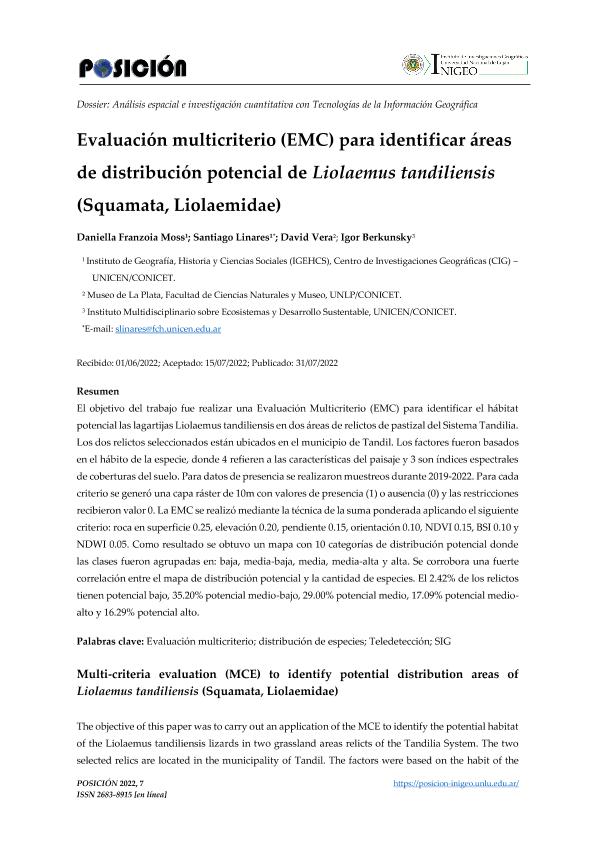Artículo
El objetivo del trabajo fue realizar una Evaluación Multicriterio (EMC) para identificar el hábitat potencial las lagartijas Liolaemus tandiliensis en dos áreas de relictos de pastizal del Sistema Tandilia. Los dos relictos seleccionados están ubicados en el municipio de Tandil. Los factores fueron basados en el hábito de la especie, donde 4 refieren a las características del paisaje y 3 son índices espectrales de coberturas del suelo. Para datos de presencia se realizaron muestreos durante 2019-2022. Para cada criterio se generó una capa ráster de 10m con valores de presencia (1) o ausencia (0) y las restricciones recibieron valor 0. La EMC se realizó mediante la técnica de la suma ponderada aplicando el siguiente criterio: roca en superficie 0.25, elevación 0.20, pendiente 0.15, orientación 0.10, NDVI 0.15, BSI 0.10 y NDWI 0.05. Como resultado se obtuvo un mapa con 10 categorías de distribución potencial donde las clases fueron agrupadas en: baja, media-baja, media, media-alta y alta. Se corrobora una fuerte correlación entre el mapa de distribución potencial y la cantidad de especies. El 2.42% de los relictos tienen potencial bajo, 35.20% potencial medio-bajo, 29.00% potencial medio, 17.09% potencial medioalto y 16.29% potencial alto. The objective of this paper was to carry out an application of the MCE to identify the potential habitat of the Liolaemus tandiliensis lizards in two grassland areas relicts of the Tandilia System. The two selected relics are located in the municipality of Tandil. The factors were based on the habit of the species, where 4 are related to landscape characteristics and 3 are spectral indices of land covers. For presence data, samples were taken during 2019-2022. For each criterion, a 10m raster layer was generated with values of presence (1) or absence (0) and the restrictions received a value of 0. The MCE was through the weighted sum technique applying the criteria: surface rock 0.25, elevation 0.20, slope 0.15, orientation 0.10, NDVI 0.15, BSI 0.10 and NDWI 0.05. As a result, a map was obtained with 10 categories of potential distribution where the classes were grouped into: low, medium-low, medium, medium-high and high. A strong association between the potential distribution map and the number of species is corroborated. 2.42% of the area has low potential, 35.20% with medium-low potential, 29.00% with medium potential, 17.09% with medium-high potential and 16.29% with high potential.
Evaluación multicriterio (EMC) para identificar áreas de distribución potencial de Liolaemus tandiliensis (Squamata, Liolaemidae)
Título:
Multi-criteria evaluation (MCE) to identify potential distribution areas of Liolaemus tandiliensis (Squamata, Liolaemidae)
Fecha de publicación:
07/2022
Editorial:
Universidad Nacional de Luján. Instituto de Investigaciones Geográficas
Revista:
Posición
e-ISSN:
2683-8915
Idioma:
Español
Tipo de recurso:
Artículo publicado
Clasificación temática:
Resumen
Palabras clave:
EVALUACIÓN MULTICRITERIO
,
DISTRIBUCIÓN DE ESPECIES
,
TELEDETECCIÓN
,
SIG
Archivos asociados
Licencia
Identificadores
Colecciones
Articulos(IGEHCS)
Articulos de INSTITUTO DE GEOGRAFIA, HISTORIA Y CS. SOCIALES
Articulos de INSTITUTO DE GEOGRAFIA, HISTORIA Y CS. SOCIALES
Citación
Franzóia Moss, Daniella; Linares, Santiago; Vera, David Gustavo; Berkunsky, Igor; Evaluación multicriterio (EMC) para identificar áreas de distribución potencial de Liolaemus tandiliensis (Squamata, Liolaemidae); Universidad Nacional de Luján. Instituto de Investigaciones Geográficas; Posición; 7; 7-2022; 1-12
Compartir




